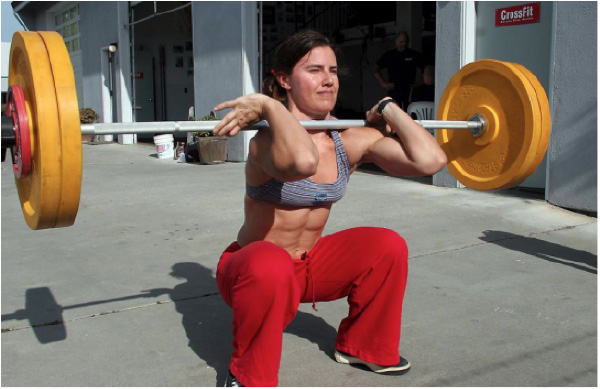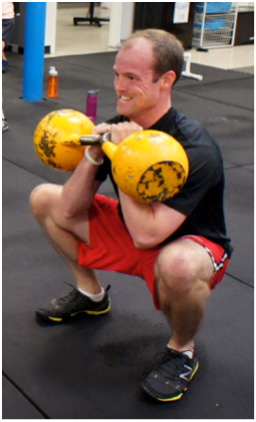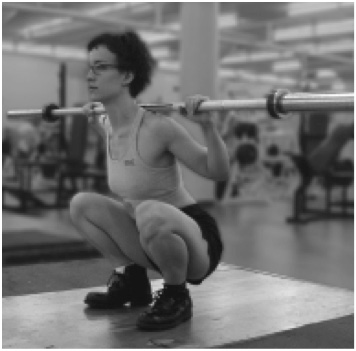
King Squat Why we squat the way that we do; and why you should also
ront squat perfection: our athletic lifter exhibits perfect position as she comes erect and is encountering the beginning of her squat sticking point. She must power thru the sticking point with compromising her perfect position. She purposefully grinds erect, using low-speed torque instead of explosive horsepower. The rep tempo is "even" both asscending and descending. We advocate a full range-of-motion (ROM) combined with a purposeful grind speed and a pause in the bottom. We make the difficult, squats, more difficult by using "intensity enhancers, i.e., perfect techniques, full ROM, paused, grind-speed, knees out squatting. Empircal experince has shown this approach to be the most efficient way to ingrain "proper" squat technique and build maximum leg size and leg power. By slowing down the rep speed we are able to conciously ascertain proper position during every inch of descent/ascent. We eliminate uncontrolled freefalling on the descent and sloppy exploding on the ascent. We pause at the bottomost point; it all combines to make the difficult all the more difficult and light weights heavy.
The once and future King of progressive resistance exercises: Why is the squat the King of all exercises? Let me count the ways…firstly, when it comes to building leg power, proper squats, upright squats, squats done with a perpendicular torso using nothing but quads to power ponderous poundage erect, was, is and forever shall be unsurpassable for infusing human legs with power, strength and size. The proper full squat stimulates more muscles than any other single progressive resistance exercise. The truthfulness of the last statement hinges on the defining of word "proper." Proper means deep and proper means all legs.
No one does proper full squats anymore. The reason are numerous, suffice to say "experts'' of every type and kind have either damned full squats as dangerous - or worse, champion this superb exercise, but teach some perverted technical abomination, some bastardized squat travesty that blends and bleeds and is a mockery of all that is good and right and productive about classical, pristine, proper upright ultra-deep squatting, be it front squatting, back squatting, kettlebell squatting or no-weight squatting. Our core technique for all squat variations is identical. The hardcore squatter's sound-bite bumper sticker motto is, "Shallow squats are worthless squats. Friends don't let friends squat high."
Physiologically, when an athlete squats properly, they attain the perfect balance between technique and payload. All good things spring from the barely completed final rep(s) of limit top set(s) of proper squats. It is the degree of pure physical effort (AKA intensity) that triggers the adaptive response and sparks muscle hypertrophy. From hypertrophy springs size, strength and power. Strength and size building only occur in response to super-human effort. Why would fabulous results occur in response to normal effort?
Tangible physiological results require friction, pressure, in order to turn a lump of coal, your body as it is, into a diamond, your body, as you would like it to be. If sub-maximal effort triggered real results, the world would be overrun with lean, muscled humans. In order to reap factual results we need exert inhuman, superhuman effort. No matter where we are physical feeding chain is irrelevant, regardless our status, exalted or lowly, all that is required to reap maximum results is for you, on an individualized basis, approach, equal or exceed current limits in some manner or fashion.
- The proper squat has a specific technical template: rep after rep, each repetition is perfect and identical to its rep predecessor and will, in turn, be identical to its rep successor.
- The upright squatter uses an open stance, a "knees-out" ascent/descent and a full ROM. We force the quadriceps to do the all the work. We make squats a leg exercise, not some inferior hybrid/mongoloid technique that spreads the muscular effort between quads/hips/lower back and hamstrings.
- The sticking point is the marrow, the irreducible core essence of any result-producing rep. Without struggle there is no adaptive response. Why would there be? Those in the know understand that the true goal of resistance training is to create opportunities to struggle through sticking points. The hardcore elite understands that how a man conducts himself during the rep struggle determines the degree and depth of results. There is an irrefutable relationship between degree of struggle and depth and degree of results.
- The rest of the squat world seeks ways to avoid the squat sticking point, providing tips and advice on how to ‘slip through' or avoid the sticking point with some new trick. We seek out the squat sticking point and then power through it (or not!) understanding that struggle, and the barely completed rep, is where the true gains lie. Super-human effort, repeated struggling through sticking points, is required to trigger gains.
Done properly, the squat is unquestionably the most excruciating of all progressive resistance exercises. There is something truly dangerous about having to have maximum poundage on top of you and then squatting up to and past current limits; complete collapse a real possibility. It is dangerous thing to have a barbell set heavy enough to hurt you on your back or clavicles as you push your guts out during a limit rep - that you might miss. When a man misses a squat, he must ride it down to the safety pins in the power rack, or, if he is lucky enough to have training partners, alert spotters will catch the downward barbell.
A limit set of squats activates every muscle on the human body to a greater or lesser degree: traps are maximally stimulated when you set a weighted barbell atop them, the ribcage must fight to lift and inhale between back squat reps, the abs receive more benefit than 100 effete crunches as they flex to cramping to stay upright on the squat descent/ascent, deep squats create a core of iron, hamstrings and calves fire on every rep, the erectors fight to keep the torso upright, every muscle stabilizer on the human body goes to DefCon 5 when performing a limit set of ultra-deep squats.
No other progressive resistance exercise triggers the primal, fight-or-flight psychological response to the degree limit squats do; limit squatting unleashes a cascade, a hormonal tsunami of tremendous benefit. We seek ways in which to increase squatting's degree of difficulty. Why would we take the world's most excruciating exercise and multiply the degree of difficulty exponentially? Why would we require the squatter to descend to ass-on-heels depth on every rep of every set? Why would we further increase the degree of difficulty by adding a purposeful pause at the bottom of each super-deep rep? We strengthen the squatter over every inch of the ROM, no Achilles heel, no zone of zero strength. Simultaneously we maximize muscle growth and exponentially increase our quota of brute power. Strict techniques limit poundage-handling ability: we obtain more using less; minimal payloads reap maximum physiological results.

After having sunk as low as possible, and while maintaining a bolt-upright torso, the squatter pauses a beat before ascending. How a man arises from a paused, upright, ultra-deep squat determines the amount of benefit he will derive. The double-kettlebell squatter pictured is exhibiting good bottom position. His depth is maximal, his torso is upright and now he need engage his GRIND gear and slowly (but not too slowly - barely slow) and methodically torque himself erect, using legs and legs alone. When he encounters the maximum resistance, deep within the sticking point, he forces his knees out maximally. All subsequent squat variations are built upon this excruciating core technique. This man will fail with integrity rather than perform some trick to slide through the sticking point. True squatters embrace the struggle. They understand the results occur only when fighting through growth-producing sticking points. We seek the barely completed rep.
- Key technical point: never let the tailbone "shoot upward" at the instant the ascent portion begins. The natural inclination is to "make it easier" on the legs coming out of the bottommost squat position. The tailbone shoots upward, allowing the legs to telescope and extend, putting them in much more favorable push position. It's a devil's bargain. Letting the tailbone shoot up causes the squat bar to end up forward, in front of the feet and now the spinal column must be derricked erect, using the hip-hinge and a few tortured vertebra perpetually on the verge of rupturing.
- The proper procedure is to sink to the bottommost position. As the squatter descends to parallel (where the rest of the squat world reverses gears and heads upward) we exhale and relax the thighs, allowing the poundage to push the squatter downward into the bottommost position. Maintain an upright torso.
- When descending, the best way to attain a vertical torso is to push the glutes rearward as you descend on each and every rep. Establish and maintain the vertical torso on the descent. While sitting erect in the bottom position, inhale mightily and grind erect, using a purposefully slowed rep speed - but not too slow - barely slow.
The key is to use light poundage or no poundage (initially) and ingrain proper technique each step of the way; we make squat haste slowly and never sacrifice technique for poundage. The purposefully slowed "grind" speed is an expression of low-end torque. Think of explosiveness as an expression of high-end horsepower. The actual speed of the grind rep is not (and should never be) radically slowed - that is a fatal mistake slow-rep proponents and adherents make continually. They slow the rep speed to such a degree that it completely destroys poundage handling ability. Strength plummets to an unacceptable degree.
- The preferred Grind speed is "barely slowed." The ascent, the upward motor-pathway of the leg push, is a mirror image of the preceding precise and precision lowering.

Now GRIND erect! This lifter demonstrates good bottom position in the paused, hi-bar back squat: her knees are a little too forward (attributable to her pinched stance) but other then that, this gal is ready to grind erect. During the ascent, her hips need stay under her shoulders: no forward lean! The lifter's femurs (upper thighs) move upward to power her from the bottom to lockout. Knees are forced out on both descent and ascent. The trick is to not let the tailbone shoot upward when the ascent starts.
- Those that embrace the hard start are rewarded with an easy squat finish. The sloppy squatter grabs the low-hanging fruit of the easy squat start and allows the tailbone to shoot upward. Now the payload is way forward and the lifter is confronted with the agony of a spine-busting finish. The barbell is now badly out-of-position; way forward and must be "back-hinged" to lockout.
We "make light weights heavy" by layering "intensity boosters" atop full range-of-motion squats. We add pauses atop grind rep speed to make the already tough tougher; we create the ultimate in excruciating exercise. Repeatedly grinding full ROM paused squats ingrains proper technique in a way like no other. We create a rock solid foundation for all future squat (and deadlift) efforts.
The squat zone of no strength and no protection: Perhaps the single most identifiable characteristic that define our squat technique is the degree of "depth" we insist on. We want our squat trainees to travel over the longest possible range-of-motion on each and every squat rep. This approach, maximal squat depth, is oddly controversial in the mainstream athletic, strength training and power sport world. The squat depth we proscribe has been described as "insanely deep," "dangerous," "completely wrong" and "inappropriate weightlifting squats." We disagree. We do not, arbitrarily shorten stroke length on other exercises - why should we on squats? If an exercise has a definable and doable range-of-motion why would you purposefully limit the rep stroke and shorten the ROM on one particular exercise?
Imagine if a man is bench-pressing and this man has a full range-of-motion, a chest to lockout rep stroke of 18 inches. He begins doing "half" bench presses, stopping the barbell halfway down, lowering the barbell (or dumbbells) 9 out of 18 inches. By shortening the rep stroke, the bench presser is suddenly able to handle a lot more poundage. Over time, his ego causes him to shorten this already shortened rep stroke further. Now, instead of lowering halfway down he lowers the barbell a mere sixes inches before reversing directions and without pause push the payload upward.
He can now handle a huge amount of weight - and he practices his 6-inch rep stroke bench technique exclusively for the next few years. He becomes capable of handling 315 for 8 reps in the six-inch bench press - but his dirty little secret is if he accidentally goes one inch below his six inch ingrained power stroke, he has no strength, none, and the barbell will collapse on him like a building in an earthquake.
Because our six-inch rep-stroke bench presser has never trained outside his particular zone of strength, if he were to experience a lapse in concentration and without thinking lower 315 eight inches, his arms would collapse and the 315 would crash down on his chest, delivering all its fearful concentrated impact in the form a 1¾ inch round barbell. That's a surefire rib-breaker. Plus, from a muscle and strength building perspective, partial reps yield partial results.
We have the identical situation in squatting. We somehow have been talked into the weird equivalent of not lowering the bench press bar all the way down to the chest: why wouldn't we squat all the way down? Why do we purposefully curtail the rep stroke length, and thereby the results - by only descending to parallel - or higher. Those few that bother to squat in our Virtual Age will do half squats, the exactequivalent of the guy that only lowers the bench pressing bar six inches. At least the parallel squatter goes halfway down. While we have no problem grasping the ridiculousness of the half-bench or the six-inch bench press, the ludicrousness of the half or parallel squat eludes us.
When we champion maximum range-of-motion squats, we are accused of resistance training instructional malpractice. To squat that deep, the delicate relate, will no doubt blow out your knees and cause the deep squatter to become a permanent cripple confined to a wheelchair. Despite their being called on it, and despite being unable to produce a single deep squat cripple or blown knee victim, the seriousness of accusation gets traction in the wider athletic training community: super deep squats with big heavy barbells are dangerous.
Meanwhile those that were squatting super deep using pristine, "all leg" techniques develop injury proof knees and obtain astounding muscle and power results. Deep squatters using periodized squat routines will experience radical increases in lean muscle mass, strength and power in 12-weeks. The hardcore squat elite use periodized templates. They set realistic goals and works backwards, they reverse engineer to a starting point, twelve weeks prior. We take elite methods, detune, dilute and make them user friendly; we retain the core essence of the methodology.
Twelve-week squat training cycle for the beginner
| Week | session 1 Saturday | session 2 Tuesday |
|---|---|---|
| 1 | no weight 1 set of 5 | no weight 2 sets of 6 |
| 2 | no weight 3 sets of 6 | no weight 2 sets of 10 |
| 3 | empty bar 45 lbs. 3 sets of 5 | empty bar 45 lbs. 2 sets of 8 |
| 4 | 1 sets of 5 with 55 | 1 set of 5 with 60 |
| 5 | 2 sets of 5 with 60 | 1 sets of 5 with 65 |
| 6 | 2 sets of 5 w/65 pounds | 3 sets of 5 with 65 |
| 7 | 1 sets of 5 w/70 pounds | 2 sets of 5 with 70 |
| 8 | 3 sets of 5w/70 pounds | 1 sets of 5 with 75 |
| 9 | 2 sets of 5 w/75 pounds | 3 set of 5 with 75 |
| 10 | 1 set of 5 w/80 | 2 sets of 5 with 80 |
| 11 | 3 sets of 5 w/80 | 1 sets of 5 with 85 |
| 12 | 2 set of 3 w/90 | 1 set of 1 with 95 |
| 13 | report card week | one set of one rep with 100 pounds |
About the Author
As an athlete Marty Gallagher is a national and world champion in Olympic lifting and powerlifting. He was a world champion team coach in 1991 and coached Black's Gym to five national team titles. He's also coached some of the strongest men on the planet including Kirk Karwoski when he completed his world record 1,003 lb. squat. Today he teaches the US Secret Service and Tier 1 Spec Ops on how to maximize their strength in minimal time. As a writer since 1978 he’s written for Powerlifting USA, Milo, Flex Magazine, Muscle & Fitness, Prime Fitness, Washington Post, Dragon Door and now IRON COMPANY. He’s also the author of numerous books including Purposeful Primitive, Strong Medicine, Ed Coan’s book “Coan, The Man, the Myth, the Method" and numerous others. Read the Marty Gallagher biography here.

